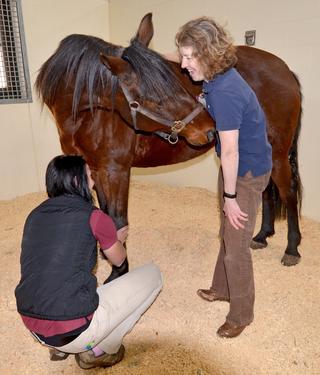- Issue:
In the busy academic setting, students report that it is rare to get in-the-moment feedback. Laura Molgaard is looking to challenge this norm with the incorporation of a new entrustment scale into the CVM rotation curriculum. The entrustment scale she developed with colleagues in an international working group—under the auspices of the Association of American Veterinary Medical Colleges—geared toward veterinary education is currently being tested in seven different clinical rotations. It aims to improve both the frequency and quality of feedback students receive through the use of immediate coaching.
Molgaard, DVM, associate dean of Academic and Student Affairs, compares this approach to coaching a basketball team. “The coach would not do what’s typical in a vet school paradigm. They would not email the athlete at the end of the season with something that says, ‘Thanks for being on the team. Keep learning about basketball to get better at basketball.’ But that’s the kind of feedback our students often get,” she says. “What we want instead is, ‘Good job jumping for the rebound. Next time, box out’—in-the-moment, specific coaching.”
“I had a great experience with the EPA feedback system because it provided relevant feedback in the moment, so I was able to use it for improvement. The feedback is always constructive, and it doesn't come weeks or months later.”
Isaac Secor, '19 DVM
The entrustment scale is currently set up to evaluate a student’s performance level on a given Entrustable Professional Activity (EPA) through the use of an online form. EPAs, developed specifically for this system, are comprised of eight different professional tasks that a learner can eventually be trusted to perform on their own. When a faculty member is ready to provide feedback, they provide it verbally and then go online and select the EPA that they’re evaluating. They then select an entrustment level, which ranges from “observation only” to “allowed to practice under on-demand supervision.” After the entrustment level is selected, the rater is able to provide specific narrative comments. This way, students receive feedback verbally and it is also logged.
By encouraging faculty, staff, and students to embrace a culture where feedback is welcome, Molgaard also hopes to initiate a shift from a fixed mindset to a growth mindset in DVM students. Students who have experienced rotations where the new entrustment scale is in use find the feedback extremely useful. Fourth year veterinary student Isaac Secor says, “I had a great experience with the EPA feedback system because it provided relevant feedback in the moment, so I was able to use it for improvement. The feedback is always constructive, and it doesn't come weeks or months later.”
Faculty experience with the system is being explored more in-depth through focus groups this spring, but the response so far is largely positive. Erin Malone, DVM, PhD, professor in the Department of Veterinary Population Medicine, used this process in the food animal surgery and anesthesia rotation this winter. She says, “This was the first time I could meet my longtime goal of giving daily feedback. And it actually made it easier to give end-of-rotation grades.” A bigger, multi-institutional research project based on this system is currently being developed with the goal of comparing the EPA rating system to the traditional way students are evaluated on clinical rotations.
The implementation of the entrustment system has already begun to see encouraging results. Molgaard says, “In some rotations, we are seeing learners taking ownership of their feedback. They ask for it. The faculty here have to initiate it most of the time now, and we need to build a culture for feedback.”
Photos courtesy of Laura Molaard and Erin Malone


